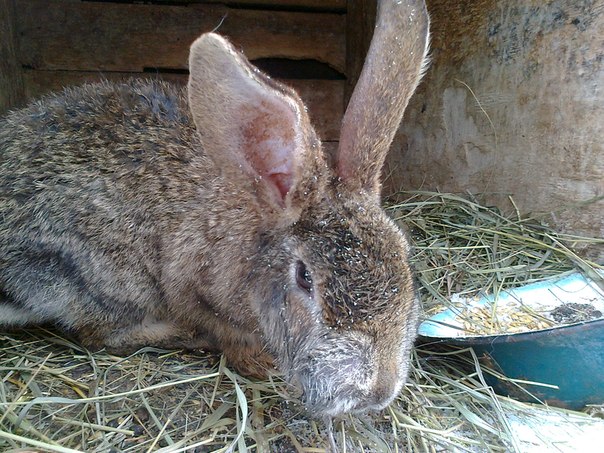Rabbit breeding is a popular branch of the household. After all, these pets have a high fecundity, and their meat has a high value. However, breeding does not always proceed as smoothly as we would like.
Many farmers who breed rabbits know that these individuals are prone to disease, leading to dire consequences. One of the dangerous diseases that often occurs in these animals is myxomatosis.
If during the time not to provide appropriate treatment, then as a result all the livestock may die. In this article, we will examine the symptoms of myxomatosis in a rabbit, learn how to treat a disease, and whether it is dangerous for humans.
Table of contents
Symptoms of myxomatosis in rabbits
If you suddenly began to notice that your rabbit offspring began to suffer from any disease, then for starters, it is worthwhile to determine what kind of disease you have to fight. To determine the disease you need to pay attention to the appearance and behavior of individuals. In the presence of infection, the offspring become passive, many individuals lose their appetite, they become sluggish.
However, with myxomatosis, there are a number of symptoms and signs that should be paid special attention from the first days of appearance:
- First, serious eye damage occurs. The first signs of conjunctivitis appear on the mucous membrane of the eyes. Then from the eyes appear discharge, which have a milky structure. After that, they become very swollen and inflamed;
- Inhibited movements. With myxomatosis in rabbits, the movement is inhibited, slow.At this time, he does not move as confidently and actively as usual;
- Sharp increase in body temperature. Body temperature at this time can rise to +42 degrees. To the touch the body of individuals is hot, sometimes even fiery;
- Deterioration in the quality of wool. The structure of the rabbit's fur loses its bright and saturated color. To the touch it becomes tough. In addition, even with light stroking shreds of wool fall out;
- In addition to eyes, lips, ears, nose, and eyelids swell up. Sometimes there are inflammatory processes of the organs of the reproductive system;
- During the transition to severe disease individuals are almost always lying and even the ears cannot lift;
- Sometimes the animal may fall into a coma, from which it is rather difficult and sometimes impossible to remove him;
- On the nose, ears and paws fibrous nodes are formed.
Often, the owner does not pay attention to the first symptoms of the disease, because at the first stage it does not manifest itself.Therefore, individuals so not receiving proper treatment die. It occurs within 2 days or 48 hours. Sometimes there are cases when individuals in such a serious condition lived for another 2 weeks.
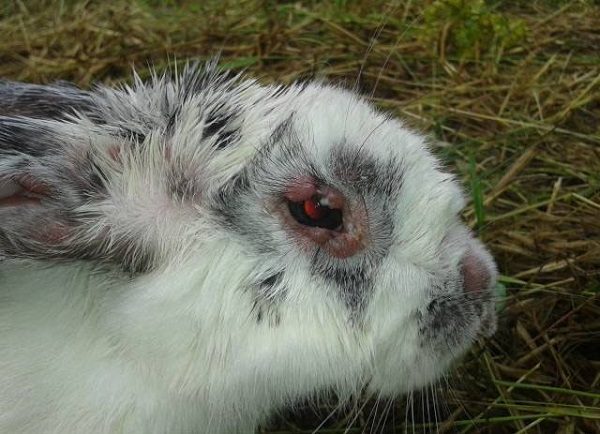
Sometimes, along with myxomatosis, other associated infectious diseases occur in rabbits., which greatly worsen the condition of individuals. During myxomatosis, pneumonia occurs, which is fatal to the animal. In these cases, it is necessary, as soon as possible, to carry out the appropriate treatment, which consists of vaccination and vaccination of rabbits against myxomatosis.
How does the infection occur?
It is worth remembering that myxomatosis is transmitted through insects. Blood sucking insects are carriers of this disease:
- Mosquitoes;
- Mosquitoes;
- Flies;
- Midges;
- Fleas;
- Lice;
- Ticks.
The peculiarity lies in the fact that these insects are not sick with this disease, they simply carry its virus on their paws. As soon as any of these insects lands on an animal, it carries the virus from its paws onto it and as a result the rabbit is immediately infected with myxomatosis virus.
Sometimes birds act as carriers of this disease, they carry the virus of the disease on the claws. Accordingly, when a rabbit comes in contact with this bird, the rabbit is immediately affected by this disease.
Treatment of myxomatosis at home
Now let's talk about how and how to treat myxomatosis in rabbits. Many experts believe that the treatment of myxomatosis in rabbits at home is quite complicated. However, this is a controversial issue. If you start the treatment of this disease in the earliest terms, then you can cure it completely in a short period.
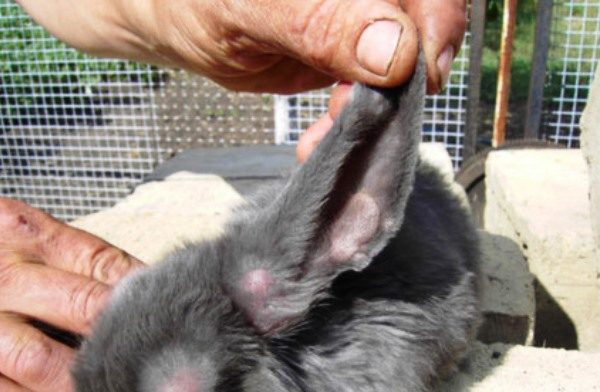
Vaccination
Vaccination does not provide complete protection against the disease, but provides for its flow in a mild form and reduces the risk of its occurrence in the future. In addition, after vaccination, the survival rate of individuals increases significantly.
In rabbits that have been vaccinated, the disease manifests itself as small swelling and nodules. These symptoms disappear after some time independently.The duration of the vaccine is 9 months.
Vaccination rules:
- Vaccination is done to rabbits at the age of one month, 7 days after weaning;
- Rabbits at the age of two months are boosted;
- Vaccination is done twice a year - in March and September;
- The vaccine must be administered with sterilized needles and syringes. Instrument to boil for at least 15 minutes;
- For each rabbit must use a separate needle. In no case should the vaccine be administered to all individuals with a single needle;
- The vaccination site is treated with a medical alcohol solution;
- After vaccination, individuals are observed for 20 days.
If the vaccination is done by the subcutaneous method, then half of the dose of the vaccine and half of the solvent are used for this. 0.5 ml of the drug is injected into the thigh.
During intradermal administration, a single dose of vaccine and 0.2 ml of solvent are used. In these cases, the drug is injected into the ear in a volume of 0.2 ml.
Antibiotic treatment
Often this disease is treated early with antibiotics and immunomodulators. Sometimes for the treatment of open wounds using alcohol iodine solution.
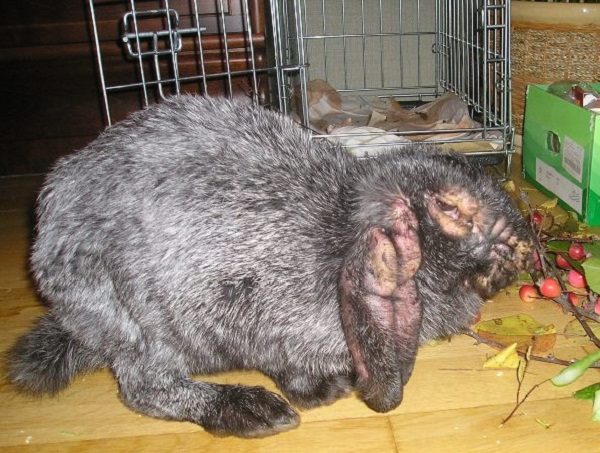
Methods of home treatment:
- Daily subcutaneous injections are given. Gamavit is injected subcutaneously in a dosage of 0.2 ml. Injections are made until complete recovery of individuals;
- Subcutaneous injections - Fosprenil 1 ml. The drug is administered 1 time per day until complete recovery;
- Week give the rabbits to drink a solution of Baytril. This medicine should be diluted in water at a dosage of 1 ml per 10 kilograms of the individual. This solution is necessary to water the rabbits daily;
- Be sure to bury your eyes with special drops, such as Ofloxacin. This drug is used as an ointment;
- Into the nose should be instilled drops of Aquamaris;
- Saline is used for washing the eyes;
- Open wounds are treated with an alcoholic iodine solution until they are completely healed;
- During the week, the rabbits are injected subcutaneously with vitamin B to strengthen the immune system;
How to treat sick rabbits with folk remedies?
In addition to drug treatment and vaccination, myxomatosis can be treated using traditional methods, namely:
- Lubrication of the affected areas with copious amounts of refined sunflower oil. To do this, pour a small amount of sunflower oil onto the pan (it is advisable to use unrefined or fresh oil) and heat it. As soon as it is heated we overcook it for 15-20 minutes. Next, dip the cotton swab into the oil mixture and lubricate all affected areas;
- Treatment with a solution of the camel spine. It is necessary to collect a full jar of these spines and fill them with hot water. Then close the jar with a lid, leave to stand for 2-3 hours. After this time, the solution must be filtered through a gauze material. This solution must be recruited into a syringe and injected into the rabbits in the shin areas. The dosage for adults should be no more than 5 ml, and for small rabbits 2 ml. Before using this recipe, you should consult a veterinary specialist;
- You can use the following recipe for wound healing.: you need to collect urine in a jar or bottle and put it in sunlight, preferably on direct rays. After 2-4 hours it will be possible to dip a cotton swab in this liquid and lubricate all affected areas in rabbits with it. The skin will heal much faster, and the smell of urine will scare away all mosquitoes and blood-sucking carriers of myxomatosis.
Edematous form
The edematous form or the classic form of myxomatosis in rabbits is considered the most severe. Its duration ranges from 4 days to 15 days. It usually ends in death.
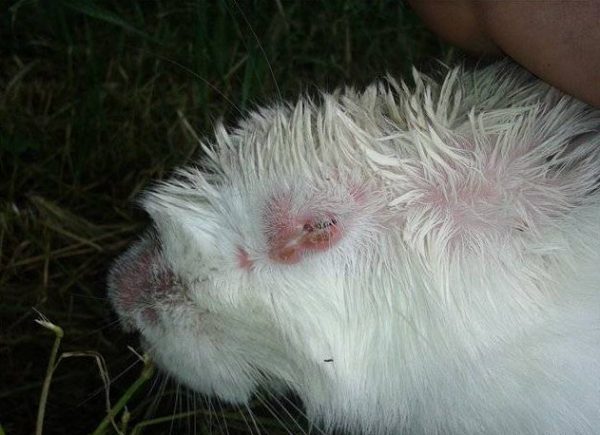
The main features of this form are:
- There are redness in the form of spots or cones on the surface of the skin around the eyelids and on the auricles;
- Lesions of the mucous membrane of the eyes, conjunctivitis manifests with purulent discharge from the eyes;
- Severe swelling of the eyes;
- Bonding eyelids;
- The appearance of liquid nasal discharge;
- Difficulty breathing.
Treatment of miskomatosis in the edematous form is not carried out, because it does not give results. If individuals develop myxomatosis in edematous form, then they should be scored. Meat after slaughter in food can not be consumed.
Nodular form
Myxomatosis in a nodular form in rabbits runs from 30 to 40 days.This form of the disease is considered the easiest, and it is characterized by the appearance of small nodules in the greatest number on the head and on the ears. Later there are signs of conjunctivitis and runny nose.
For the treatment of myxomatosis in this form, you must proceed immediately after the first days. Antibiotic drugs, vaccination and wound treatment with iodine solution are usually used to treat this form. The survival rate after this form is almost 70%.

Is it possible to eat the meat of sick animals and is it dangerous for humans?
But what about the meat of a sick animal? Myxoma disease in rabbits leaves open the question of whether their meat can be consumed after or during a disease.
There is no single answer to this question. Many experts argue that this disease does not pose a particular danger to humans and therefore, the meat of a sick rabbit can be eaten after slaughter.
After the slaughter of animals need to burn. But if you are not too squeamish, then after slaughter you can leave the carcass for further consumption. But it is advisable to carefully prepare them.
Prevention
In order to prevent the occurrence of this serious disease and to protect your rabbit offspring from infection with this infection, it is worth observing all the prephylactic recommendations:
- During the period of activity of blood-sucking insects, it is necessary to carefully protect all animals from their attack. The greatest activity of these insects is observed in May and June, during this period a special room should be equipped for rabbits, which will exclude contact with all sorts of blood-sucking insects;
- For new animals, it is mandatory to conduct quarantine activities;
- Constantly check animal fleece for fleas and lice. At their first occurrence, they must be treated with appropriate agents against these parasites;
- If the animal is sick with myxomatosis, it should be immediately transplanted into a separate cage;
- Animal cells should be regularly treated with disinfectants;
- Be sure to feed individuals, even if they have no appetite. If individuals cannot feed on their own, they are fed through a syringe;
- Pumpkin pulp and pineapple juice are added to rabbit feed. The components are mixed, the consistency of the mixture should resemble puree. This mixture should be fed to the individuals every day before and after their recovery;
- Regular and timely vaccination of all individuals.
Myxomatosis is a serious disease that usually occurs in an acute form. When it occurs, many owners are not immediately able to determine the presence of this disease. For this reason, in many individuals it goes into a severe form that cannot be cured.
Many veterinary experts advise that when a disease occurs, immediately kill animals that are sick., because often the treatment does not bring a positive result. There is also no intelligible answer to the question of whether the disease is dangerous for a person. In any case, we advise you to be safe and not risk your health.
Finally we offer to watch a small video on the topic:
